Arjan Dwarshuis Biggest Year: 29 juni t/m 25 juli
Zoals jullie weten sponsoren wij samen met Swarovski Optik, vogelaar Arjan Dwarshuis. Vanaf 1 janauri 2016 is Arjan in de race om in één jaar tijd zoveel mogelijk vogelsoorten over heel de wereld te zien. Hij wil het record op zijn naam krijgen, daarvoor moet hij meer dan 6.000 verschillende vogelsoorten zien.
Lees hier zijn vorderingen.
June 29th AN EVENING IN THE NETHERLANDS
This morning I had left Ghana and around 5 PM I arrived in my home country, the Netherlands. It felt so strange to be back, especially since I will depart again tomorrow afternoon 🙂 My mum and Camilla picked me up from the airport and together we raced to a proper Scheveningse haring stand for my favourite Dutch snack. Then it was time for birding again and with my friend and top birder Vincent van der Spek we headed towards the Province of Utrecht. On the way Dutch Birder Han Zevenhuizen pointed out a Black Tern and tried to trick in drinking a beer with him, much appreciated Han, but I’m a man on a mission and beer comes after birding haha.
Near Utrecht we were met by Michel Veldt who took us straight to a singing Icterine Warbler – with Marsh Warbler nearby. Next we went in search of one of The Netherlands’ most special bird, the European Nightjar. At an undisclosed site we patiently waited for the bird to start calling and despite the not-so-ideal weather conditions a bird started calling and even gave a fantastic fly-by.
The last target that evening was a very special one, the Corncrake, a seldom observed species with a unique rasping call – hence the Latin name Crex Crex. Michel knew a site – again I will not go into detail – where a Corncrake calls very regularly. Tonight was no exception and we heard this special bird at just a few meters distance and to make the experience even better I actually got to see the bird very well!
June 30th A MORNING IN THE NETHERLANDS AND AN EVENING IN SPAIN
After just a few hours of sleep we set off again, this time with legendary Dutch Birder Rinse van der Vliet. The weather was horrendous, I guess the rain was finally catching up after spearing me so generously in Ghana.
Despite the weather we got very lucky with our first target, Short-eared Owl. Another one of my favorite Dutch birds out of the way.
We battled the weather till about 11:30 AM and found all my targets – Little Gull, Grasshopper Warbler, Willow Tit and Arctic Tern – Thanks Rinse!
In the afternoon Camilla and I boarded the plane to Sevilla, Spain, where we arrived in the evening, just in time for some quick new birds and a late Gazpacho! I felt so incredibly tired after all the traveling and I knew I had a long drive ahead of me the next day so I decided to go for Red-necked Nightjar and Eurasian Scops Owl the following night, a bad decision in retrospect …
July 1st ROADTRIPPING THROUGH SPAIN
We were on a tight schedule today starting with a seawatch off Almonte. Targets were Scopoli’s Shearwater, Balearic Shearwater and Audouin’s Gull. There were hundreds of Scopoli’s feeding offshore, but even after an hour of trying still no Balearic and Audouin’s. We were about to dispatch when an adult Audouin’s Gull flew past, pfew…
After tracking down Western Olivaceous-, Dartford Warbler and Iberian Chiffchaff we headed north towards the legendary Extremadura, which is indeed extreme this time of the year with temperatures reaching 38 degrees Celsius.
We met Dutch Birder-living-in-Spain and owner of Ecoturex Godfried Scheur and his son Pedro at his stakeout for Rufous-tailed Scrub-robin. By now it was midday, miserably hot and I guessed our chances of finding the Robin were next to zero, but by some miracle – and a small push in the back with a playback of its call – the bird gave great views.
Before we drove to our accommodation – a lovely B&B named Finca El Rabilargo (The Iberian Blue Magpie) – we made several stops for species that I was still missing, this materialized in sightings of Black Wheatear, Eurasian Penduline Tit and several fantastic Cinereous Vultures and a bonus Bonelli’s Eagle.
At El Rabilargo our hosts Corne and Lia had prepared a delicious home cooked dinner in the garden – I have got to come back here on a more relaxed pace.
After dinner we spent a frustrating two hours looking for Red-necked Nightjar, but without success; I should have pushed and gotten this species the night before …
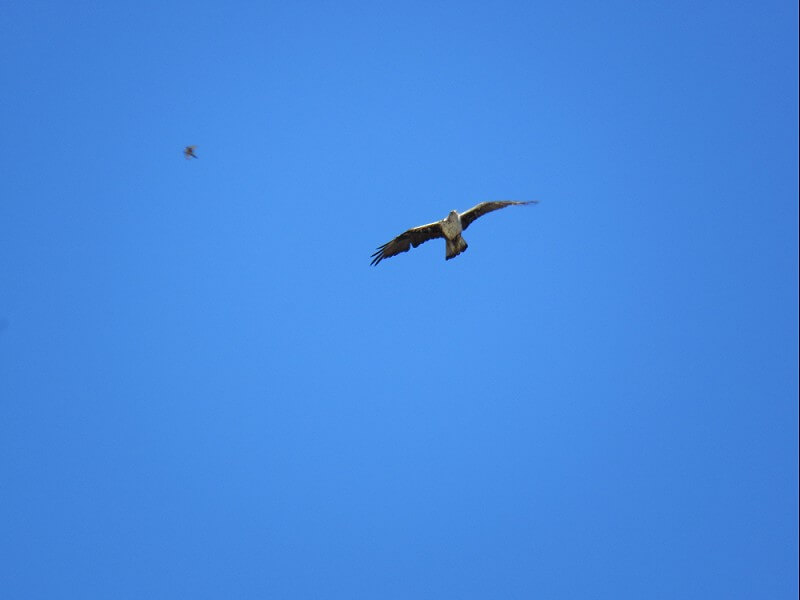 Bonelli’s Eagle Aquila fasciata (Arjan Dwarshuis)
Bonelli’s Eagle Aquila fasciata (Arjan Dwarshuis)
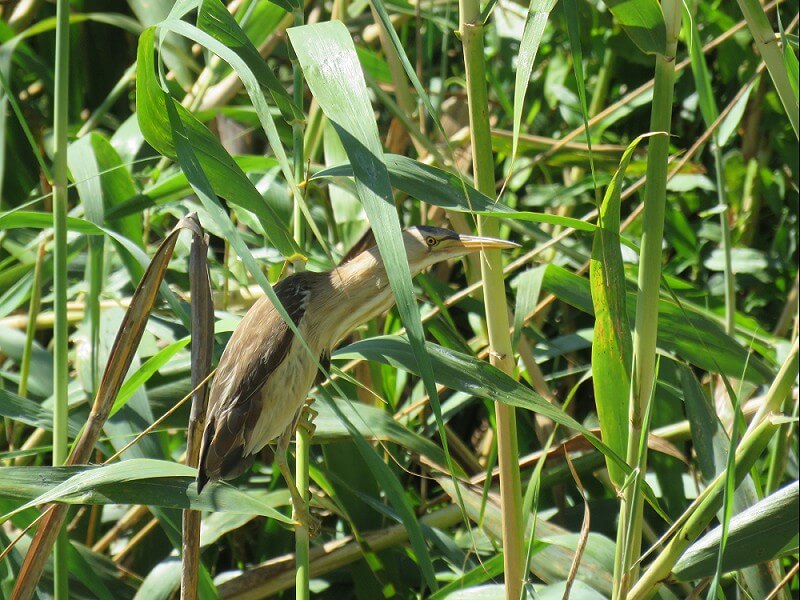 Little Bittern Ixobrychus minutus (Arjan Dwarshuis)
Little Bittern Ixobrychus minutus (Arjan Dwarshuis)
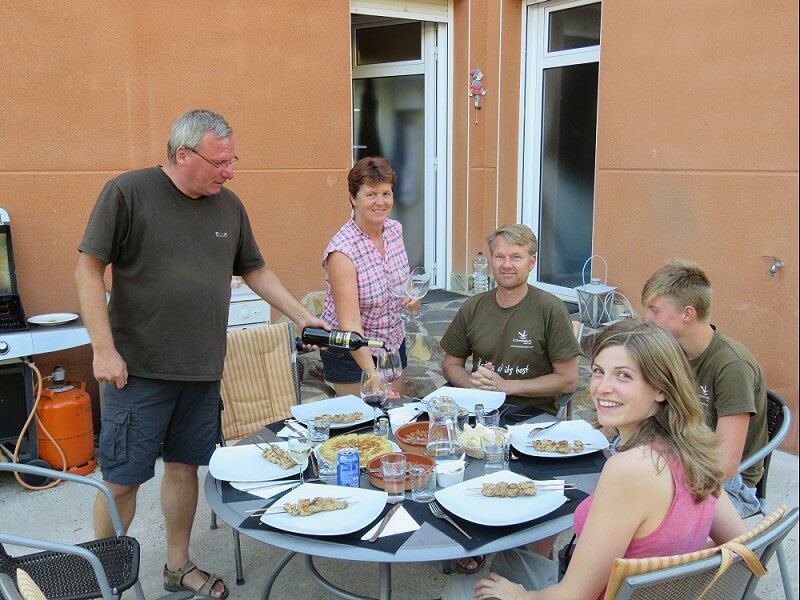 At El Rabilargo our hosts Corne and Lia had prepared a delicious home cooked dinner in the garden (Arjan Dwarshuis)
At El Rabilargo our hosts Corne and Lia had prepared a delicious home cooked dinner in the garden (Arjan Dwarshuis)
July 2nd TACKLING MY MOST WANTED EUROPEAN BIRDS
Today was a big day for me, if all went well I could see some of my last remaining European lifers on the Extremadura steppe. We left early because Godfried knew that we had to get our most important species before the heat haze started to build up.
We were joined by two fanatic Spanish birders named Jose Mazon Hernandez and Joaquin Mazon Lobo, a good thing since steppe birds can pop up or fly by from any direction at any moment. Pedro found my first and most wanted lifer, a smashing female Great Bustard that gracefully paraded across the steppe. Next came two beautiful Pin-tailed Sandgrouse that flew by at close range followed by one of Europeans rarest breeding birds, a distant adult Spanish Imperial Eagle! In the next few hours we found Cirl Bunting, Subalpine Warbler, Golden Eagle, Melodious Warbler and the beautiful Red-legged Partridge. The best bird of the day was not even a new one, a beautiful melanistic male Montagu’s Harier was something I’d never seen before and always hoped to see.
We birded until lunch when the heat was almost unbearable, than Camilla and I said goodbye to Godfried, Pedro and drove northeast towards Navarredonda de Gredos, a mountainous range 100 km west from Madrid.
Around 5 PM we arrived in the pine forest of Navarredonda de Gredos and our quest for Citril Finch started. It was a nice change of scenes to walk through a cool pine forest after birding the hot Extremadura plains earlier that day. The soon to be split Iberian subspecies of Pied Flycatcher and Bonelli’s Warbler were quickly found, but the finch took a lot more effort and it took us two hours of searching before we found a nice male. With 183 days ahead I’m now exactly half way. I’m at 3563 species, which is almost 19.5 new species a day. Tomorrow I head for the new world!
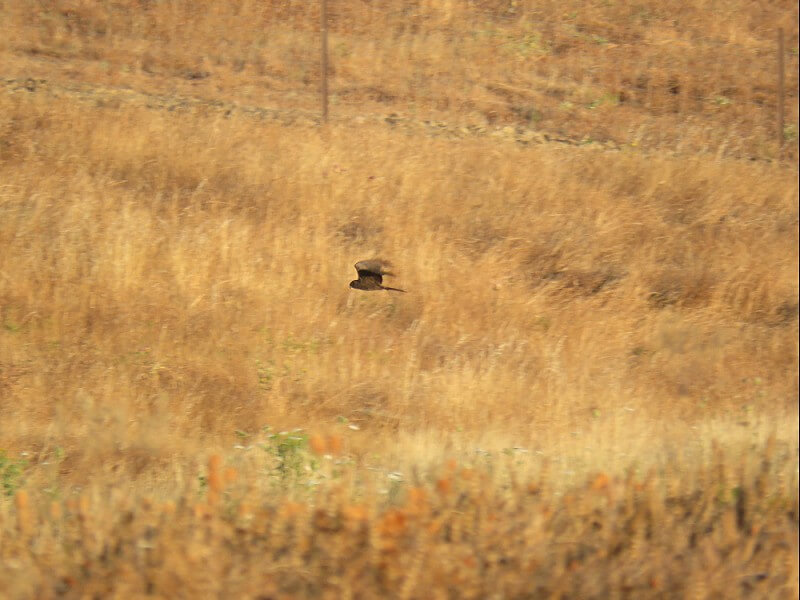 Montagu’s Harrier Circus pygargus melanistic male (Arjan Dwarshuis)
Montagu’s Harrier Circus pygargus melanistic male (Arjan Dwarshuis)
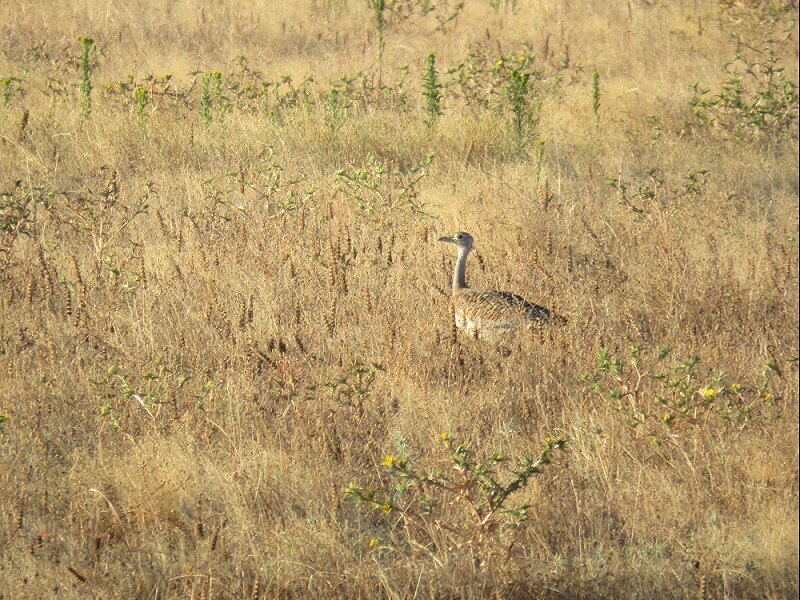 Great Bustard Otis tarda (Arjan Dwarshuis)
Great Bustard Otis tarda (Arjan Dwarshuis)
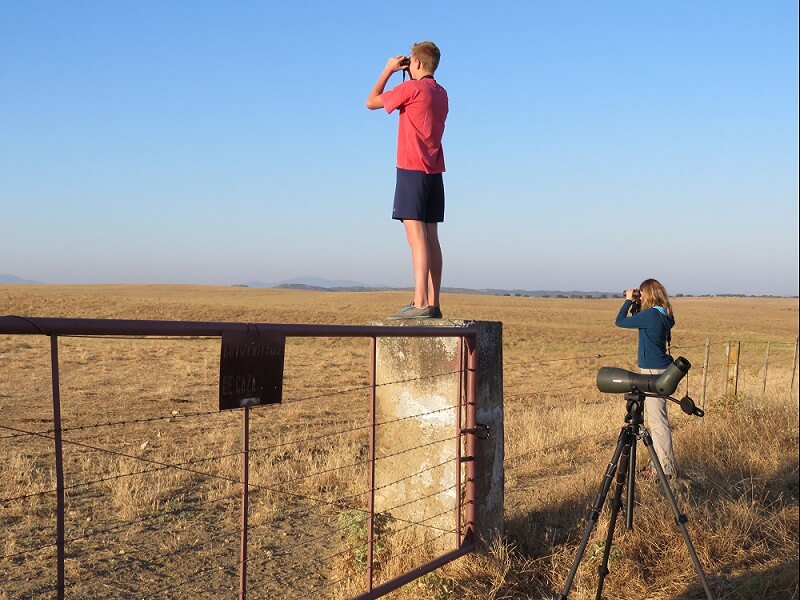 Birding the Spanish steppe (Arjan Dwarshuis)
Birding the Spanish steppe (Arjan Dwarshuis)
July 3rd A STUPID MISTAKE
My flight to Puerto Rico would leave around noon so there was only an hour of birding before we had to drive to Madrid. The pre-dawn owling session did – surprisingly enough – not produce the hoped for Eurasian Scops-owl, but right at daybreak Camilla found a Eurasian Dipper, a nice final year bird to round up the old world.
Thinking all was good I arrived at Madrid Airport ready to check in for my flight to Puerto Rico, my first destination in the New World. But then everything went pear-shaped, I tried to check in, but something was wrong. It turned out that I did not have the necessary Este (Permit) for Puerto Rico, which is after all a US State. Stupid, stupid me! I tried everything to get the Este in order before my flight with a lot of help from my parents back home, but just when I had the Este ready boarding time was over, I’d missed my first flight and all because of my own stupidity. Luckily there was the 24 hour helpdesk of my sponsor ATPIwho – again with a lot of help from my parents – managed to get me on a new flight 4 hours later. This way I would only lose a couple of hours in Puerto Rico and subsequently I would not miss more than 2 or 3 species. I dodged a bullet here …
July 3rd JUST ENOUGH TIME FOR MY FIRST PUERTO RICAN ENDEMIC 🙂
I arrived in Puerto Rico at 7 PM, just as the sun set. While the plane taxied to the gate I could write down my first new world birds like Grey Kingbird and Zenaida Dove. After I cleared customs Gabriel Lugo (Birding Tours Puerto Rico) was already waiting for me and had a nice first endemic lined up, Puerto Rican Screech-owl – we first tried several locations for Antillean Nighthawk, but with no success.
The owl showed exceptionally well as it called right over our heads. What a great bird to start the second half of my Biggest Year with!
July 4th A TASTE OF THE ISLAND LIFE
Finally a big day again! Gabriel and I left our hotel at 6 AM ready to take on a very tasty target list. Due to my unfortunate late arrival yesterday, three endemics were of the agenda, Elfin Woods Warbler, Puerto Rican Parrot and Puerto Rican Tanager. Another two endemics were not even included in the original 1,5 day itinerary because they were simply too far off-route, Puerto Rican Nightjar and Yellow-shouldered Blackbird. No worries, I will come back some day to track down those remaining five species.
We started at a very birdy patch of woodland – Puerto Rico has actually gained forest-coverage from 6% to more than 75% of its entire land surface since they almost abandoned agriculture a couple of decades ago. In the first hour of birding we had already seen half of the specials, Puerto Rican Spindalis, the stunning Puerto Rican Bullfinch, Puerto Rican Flycatcher, Puerto Rican Vireo and Puerto Rican Lizard-cuckoo, a great start.
In a patch of grassland we quickly tracked down Yellow-faced- and Black-faced Grassquit and Grasshopper Sparrow and then it was time to look for some proper specialties again around some limestone karst-forest. Here we found two very good looking birds, the Adelaide’s Warbler and the sometimes tricky Antillean Euphonia which is a likely candidate to be split in the near future along with some other striking Puerto Rican subspecies.
During the heat of the day we made a short loop along the very crowded coast – after all it was 4th of July today and Puerto Ricans love their BBQ at the beach. Here we found Caribbean Coot, Bridled Tern, Mangrove Rail and a stray American Flamingo, among others.
One of the highlights of our Puerto Rican big day was visiting the house of Jose Peppe, a naturalist who’s on a mission to video all of Puerto Rico’s birds displaying – check out this cool project on Facebook:avesdepuertoricofelpe. In Jose Peppes’ garden we saw two endemic hummers, the Green Mango and the Puerto Rican Emerald, but the absolute highlight of the day was when Jose took us to a Puerto Rican Tody’s nest, a new family for me and my most wanted Puerto Rican endemic!
Just before it was time to head back to the airport Gabriel managed to find my last two remaining targets, Loggerhead Kingbird (a proposed split) and Lesser Antillean Pewee (also a proposed split).
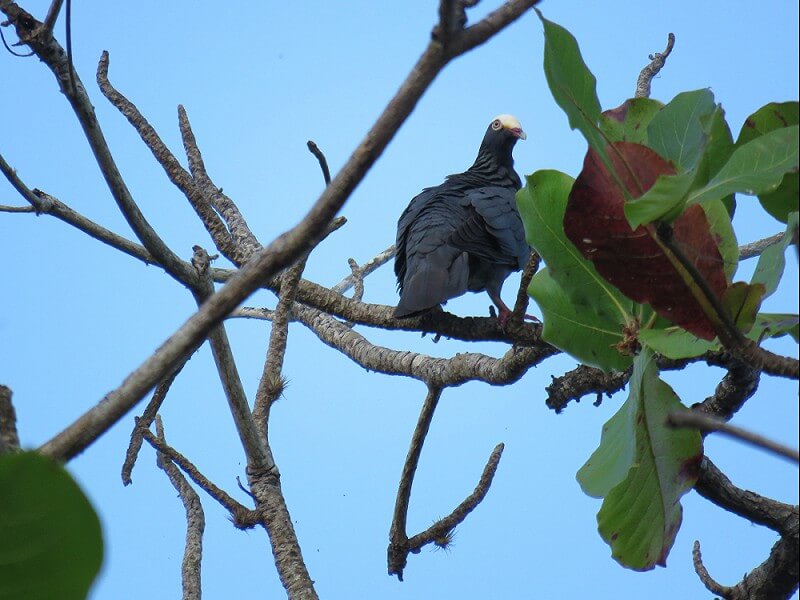 White-crowned Pigeon Patagioenas leucocephala (Arjan Dwarshuis)
White-crowned Pigeon Patagioenas leucocephala (Arjan Dwarshuis)
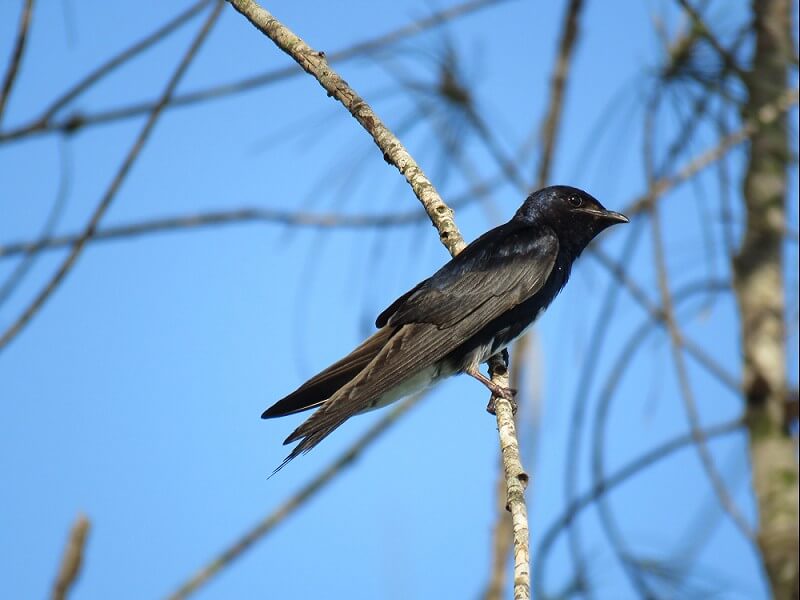 Caribbean Martin Progne dominicensis (Arjan Dwarshuis)
Caribbean Martin Progne dominicensis (Arjan Dwarshuis)
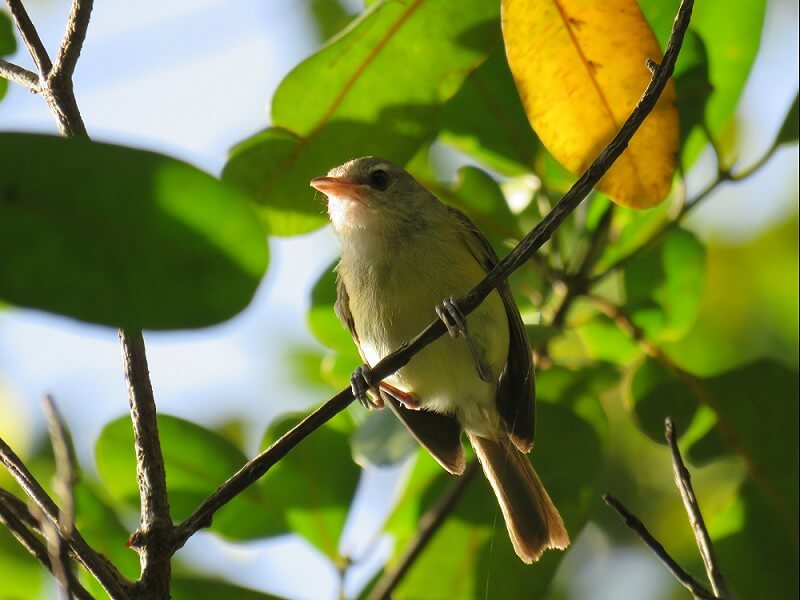 Puerto Rican Vireo Vireo latimeri (Arjan Dwarshuis)
Puerto Rican Vireo Vireo latimeri (Arjan Dwarshuis)
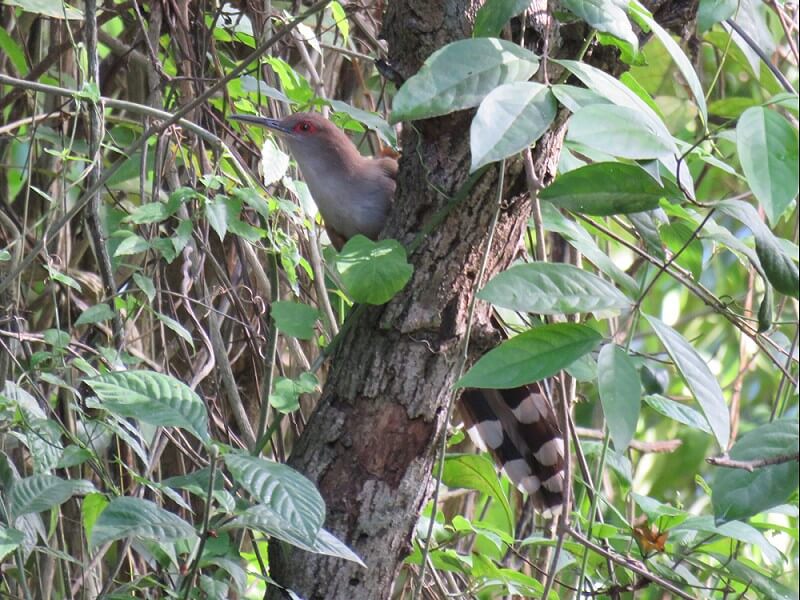 Puerto Rican Lizard Cuckoo Coccyzus vieilloti (Arjan Dwarshuis)
Puerto Rican Lizard Cuckoo Coccyzus vieilloti (Arjan Dwarshuis)
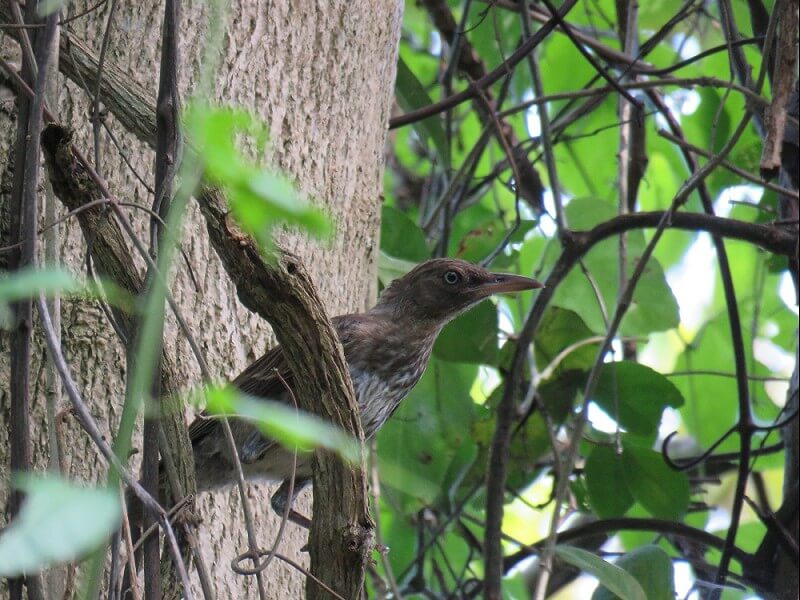 Pearly-eyed thrasher Margarops fuscatus (Arjan Dwarshuis)
Pearly-eyed thrasher Margarops fuscatus (Arjan Dwarshuis)
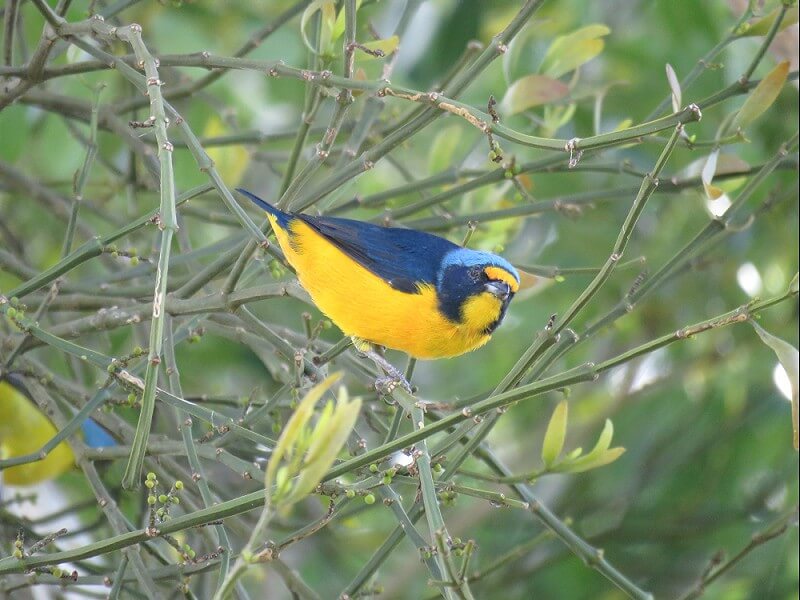 Antillean euphonia Euphonia musica (Arjan Dwarshuis)
Antillean euphonia Euphonia musica (Arjan Dwarshuis)
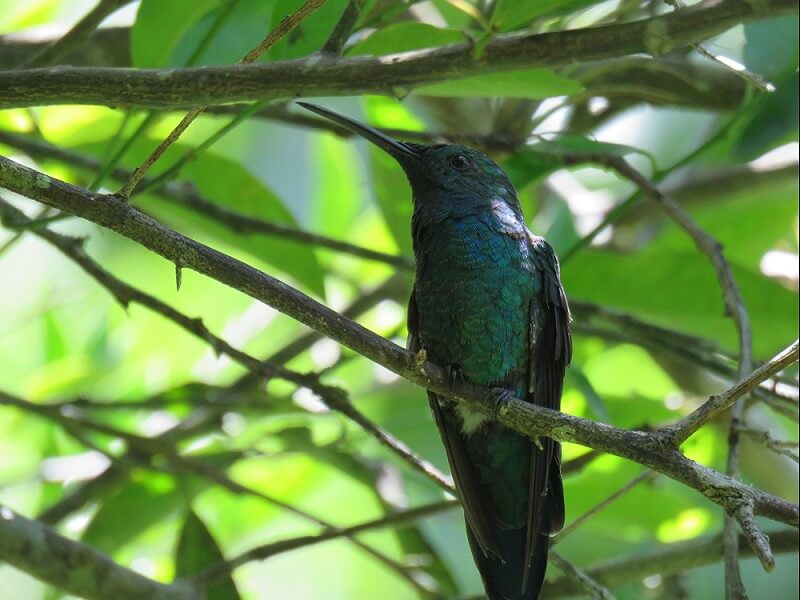 Green mango Anthracothorax viridis (Arjan Dwarshuis)
Green mango Anthracothorax viridis (Arjan Dwarshuis)
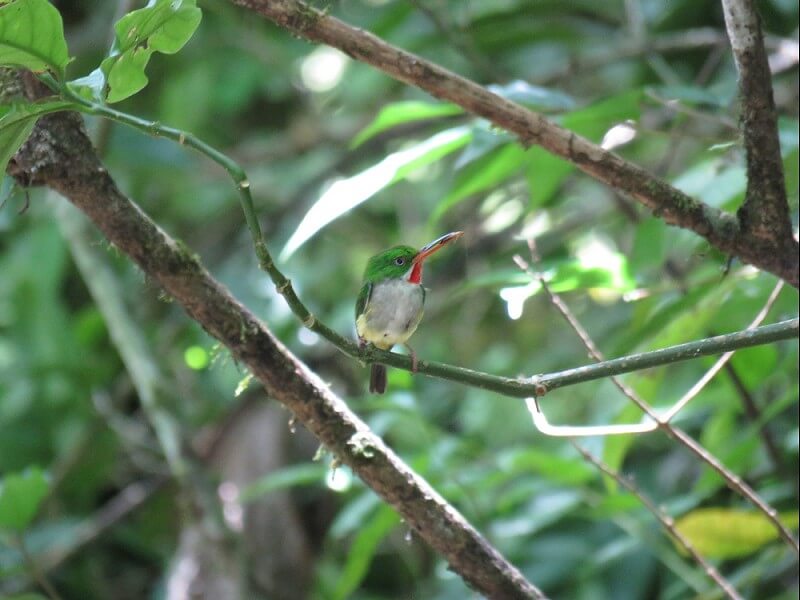 Puerto Rican Tody Todus mexicanus (Arjan Dwarshuis)
Puerto Rican Tody Todus mexicanus (Arjan Dwarshuis)
July 5th ISLAND HOPPING
Last night I’d arrived in Santa Domingo, the capital of the Dominican Republic. It took me about 3 hours to find my accommodation near the Botanical Gardens, but once I had found the Posada Dilia del Alba the place turned out to be very nice, especially considering that I paid only 18 dollars.
At 4:45 AM the alarm rang, it was time to find Antillean Nighthawk. As I walked towards the botanical gardens it slowly got light and luckily Nighthawks called from every directions and after a while I saw about a dozen.
From several different sides I had heard that the Botanical Gardens would only open at 9 AM so I’d asked Gabriel to write a letter in Spanish explaining what I came to do and if they would please let me through before 6 AM. Luckily it was not an issue at all and they let me straight through. Since the botanical gardens is the only stretch of proper green in the area it attacks quite a lot of birds, most of them being Hispaniolan endemics.
My main target – the monotypic Palm Chat – was positively abundant and their communal nests occupied about every single palm tree in the gardens. Before sunrise I had already found Hispaniolan Lizard-cuckoo, Hispaniolan Parakeet and Hispaniolan Woodpecker. My other main target – the West Indian Whistling-duck followed not long thereafter, but it took a little more searching to find the weird looking Black-capped Palm-tanager.
I left the gardens at 8:30 and after packing my bags at the Posada Dilia Alba I took a cab to the airport, ready for 3 hours of birding around the airport of Curacao. This plan unfortunately got cancelled as my flight had a 5 (!) hour delay, so some relaxed birding around the airport of Curacao changed in a hectic sprint to make my connection to Surinam. Luckily the only real target on Curacao was Cayenne Tern.
Arjan Dwarshuis
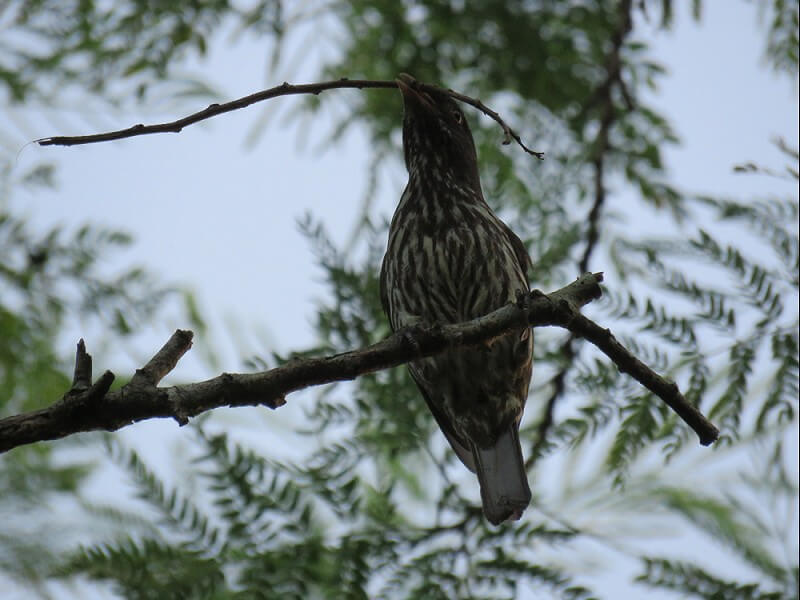 Palmchat Dulus dominicus (Arjan Dwarshuis)
Palmchat Dulus dominicus (Arjan Dwarshuis)
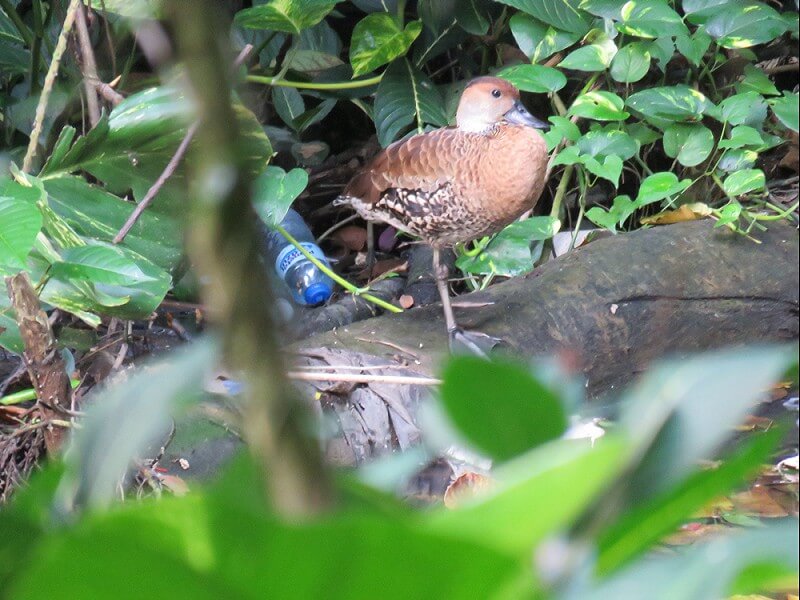 West Indian whistling duck Dendrocygna arborea (Arjan Dwarshuis)
West Indian whistling duck Dendrocygna arborea (Arjan Dwarshuis)
July 6th TOUCHDOWN IN THE NEOTROPICS
Last night I’d arrived in Suriname and after barely four hours of sleep it was time to wake up and commence with a potentially huge day. At the breakfast table I met the team for the next seven days in Suriname: Sean Dilrosum (my old friend and top Surinam bird guide), Fred Pansa (with extra-terrestrial sharp eyesight and owner of a legendary birding site named after him), Humberto Tan (Dutch television host turned hard-core birdwatcher) and my friend Michiel van den Bergh (Top world birder and director of the Biggest Year documentary). Today we were also joined by Anouk (Fred’s girlfriend) and Gini (Sean’s wife).
With the whole crew we left for Peperpot Plantage, as the name already suggest this an overgrown former plantation right on the outskirts of Paramaribo. The place is absolutely packed with birds including several Guianan Shield endemics. That is the great thing about Suriname, it is four times the size of the Netherlands but with only 500.000 inhabitants and 93% forest cover this is one of the birdiest countries in the world and one doesn’t have to travel far to find some mouth-watering species.
This was my first day birding in South America this year so new birds were everywhere. For Humberto this was his first time seeing mega mixed species flocks, skulking antbirds and canopy-dwelling tanagers, so he was almost succumbing to the enormous explosion of colour and sound that is the neotropical rainforest. Luckily we had Sean who skilfully sorted out all rarities on call. Painted Tody-tyrant, Spotted Puffbird, Amazonian Royal Flycatcher, Slender-billed Kite, Yellow-crowned Elaenia, Blood-coloured Woodpecker and of course the endemic Arrowhead Piculet were all found before 10 AM. Mammal watching was equally phenomenal with unbelievable views of three different Three-toed Sloths (of which a mother with tiny baby), a Collared Anteater and a Crab-eating Raccoon.
After a delicious roti lunch we went to visit a Crimson-hooded Manakin leg and a heronry with several stunning Boat-billed Herons and we drove to ‘Weg naar Zee’ for some open country species including the range-restricted Rufous Crab Hawk. Then we said goodbye to Anouk and Gini and with the five of us we headed for one of the most legendary birding sites of the Guianan Shield region (rounding up Bronzy Jacamar, Saffron-crested Tyrant-manakin, Olivaceous Schiffornis and Northern Slaty Antshrike).
Around 9 PM, when we finally sat down at the Brownsberg with a cold beer and a calling Spectacled Owl in the background, I counted a whopping 113 new species, making today the best day since day 1. Wow …
 Boat-billed Heron Cochlearius cochlearius (Arjan Dwarshuis)
Boat-billed Heron Cochlearius cochlearius (Arjan Dwarshuis)
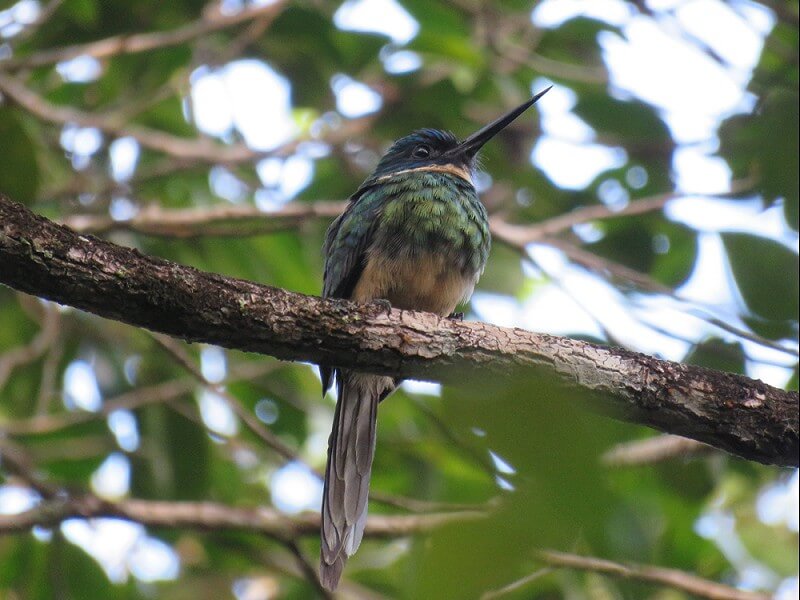 Bronzy Jacamar Galbula leucogastra (Arjan Dwarshuis)
Bronzy Jacamar Galbula leucogastra (Arjan Dwarshuis)
July 7th PHENOMENAL BIRDING
When you start a day with a pair of Lined Forest Falcons, a calling Collared Puffbird and frame-filling scope views of a male Black-throated Antshrike before sunrise, then you know you’re in for something special…
The Brownsberg is a unique protected area of primary forest situated on a 500 meter high plateau, which is absolutely teaming with wildlife. We were fortunate enough to spend three nights at this magical location. The forest here is spectacular and with fairly little effort you can find some spectacular species simply by walking across the lodge clearings or even while having diner at the lodge restaurant (which is basic, but nice). When you venture on the elaborate trail-system surrounding the lodge, the true prices of this forest can be found.
We had so many highlights that I could fill an entire page describing all of our fabulous encounters today, so here is a brief summary. We recorded over 75 new species for my year list. We saw a fantastic Slaty-backed Forest-falcon, multiple Red-and-black Grosbeaks, tame Grey-winged Trumpeters, Blue-backed Tanager, Black-spotted Barbet, White-fronted- and White-throated Mannakin, Guianan Toucanet, Green Aracari and many many more awesome birds.
July 8th FLOCK AFTER FLOCK AFTER FLOCK
When we woke up this morning Chiel was feeling a bit feverish, thinking that it might be a side-effect of the allergic reaction to the hundreds of chigger bites he had, we decided to continue birding (both Chiel’s and my own legs and especially my ankles are currently covered with hundreds of puss-filled blisters as a result to a heavy allergic reaction to chigger bites), little did we know there was a far more concerning reason for Michiel’s sudden flu symptoms…
Anyway it was business as usual on the Brownsberg, but unlike yesterday we found several large mixed species flocks, one even containing about 40 different species(!). Imagine the whole forest coming to life, movements everywhere from the canopy to the undergrowth and bird calls coming from every direction. Paradise for a birdwatcher like me, but tough conditions for someone who is completely new to this game, like Humberto. It was here on the trails of Brownsberg that Humberto found his true hobby, birding. By the end of the morning he was picking up Antwrens in the canopy and racing from scope to scope to make sure he didn’t miss any tanager or euphonia. Awesome stuff and fantastic to see someone pick up on this game so fast.
Like yesterday birding was phenomenal and highlights were many. Personal favourites were a stunning perched Ornate Hawk-eagle, Rose-breasted Chat, the skulking Ferruginous-backed Antbird, Red-billed Pied-tanager, Lineated- and Black-banded Woodcreeper, Golden-collared-, Chestnut- and Ringed Woodpeckers, Golden-headed Manakin and of course the three different Sharpbills that we saw!
July 9th DEVASTATING NEWS
When we woke up this morning Chiel was feeling worse, he was shivering even though it was 25 degrees Celsius. Something was seriously wrong with him, but since he’s tough as a nail he refused to stop birding and subsequently we headed off into the forest again like nothing was wrong. Like every day so far on the Brownsberg we saw some incredible species before breakfast, but it struck me that Chiel had to lay down even though we were looking at Short-billed Honeycreepers and Golden-sided euphonia feeding in the same tree. I opted the possibility that he had caught malaria when we were in Ghana two weeks ago since the symptoms all pointed in that direction. Damn, that might be the cause of Chiel’s illness…
Around noon we drove down from the Brownsberg to a small medical clinic to get Chiel’s blood tested for Malaria. When the results came in they were not lying, positive for MALARIA, the worse kind of malaria that is. There was no other option than to get my friend to a hospital in Paramaribo so we ordered a taxi and 15 minutes later it was an emotional goodbye. So long buddy and get yourself back on your feet man! (I have good news since just as I’m writing this, we received news that Chiel is receiving treatment and that he’s feeling better already).
So Sean, Fred, Humberto and I headed off to Fred’s Berg with the four of us thinking about our friend and hoping that he will be ok…
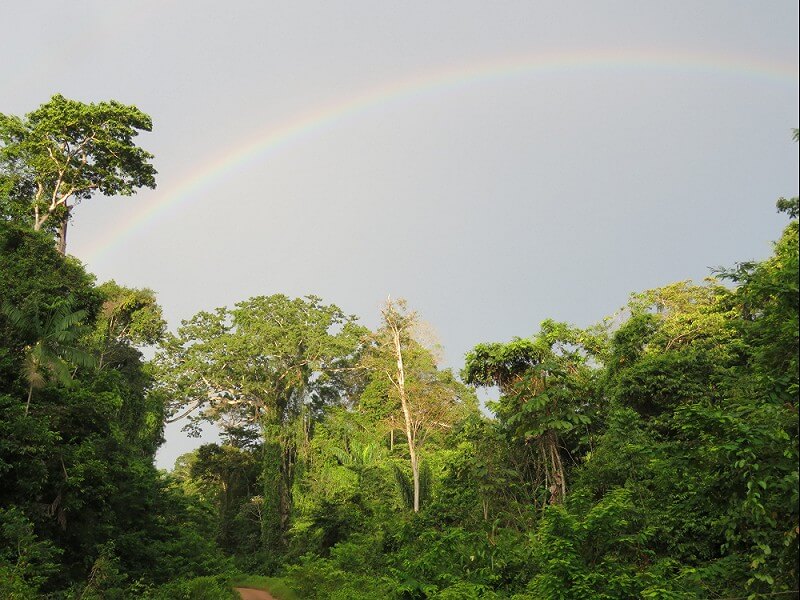 Rainbow over the rainforest (Arjan Dwarshuis)
Rainbow over the rainforest (Arjan Dwarshuis)
July 10th HARPY!
Fred’s Berg is a unique location somewhere in the middle of nowhere in the heart of the Surinam rainforest. Fred Pansa found this place by accident from a plane, while staring out of his plane window he saw a forested hill surrounded by pristine rainforest and from the moment he laid eyes on it he became obsessed with ‘Fred’s Berg’. Starting from the Brownsweg he began to hack his way to the mountain with a machete and weeks later he found it, including lekking Guianan Cock-of-the-Rocks, Harpy’s and everything that’s great about the Upper Guianan Rainforest. Now, two years later, he is building an eco-lodge and a trail system and in a couple of months this magical place is ready to receive guests. We were fortunate enough to get a sneak preview with a two night stay. Imagine sleeping in hammocks in the middle of the jungle next to a pristine black water stream, a unique experience.
After having breakfast at the camp we drove to the start of the trail system with Fred sitting on the roof to scan the treetops. Suddenly he hammered on the roof and yelled ‘STOP’! I jumped out, looked to where he was pointing and there sat a huge adult female Harpy Eagle. I couldn’t believe my eyes, what a majestic beast. We watched the bird for over half an hour before it finally flew, making this one of the absolute top sightings of my year so far.
We spend the entire day walking along the excellent trail-system to three different Cock-of-the-rock leks, but this time of the year they are not active so despite our efforts we failed to find any of these beautiful birds. The quality of the birds we did see was so high that dipping the Cock-of-the-rock was soon forgotten. We saw Opal-rumped Tanager, Boat-billed Tody-tyrant, an antswarm with White-plumed- and Rufous-throated Antbirds, White-chested Puffbird and three species of Jacamar.
Back at Fred’s camp we had a well-deserved swim in the river and had dinner by torchlight with the sounds of the jungle surrounding us, magic…
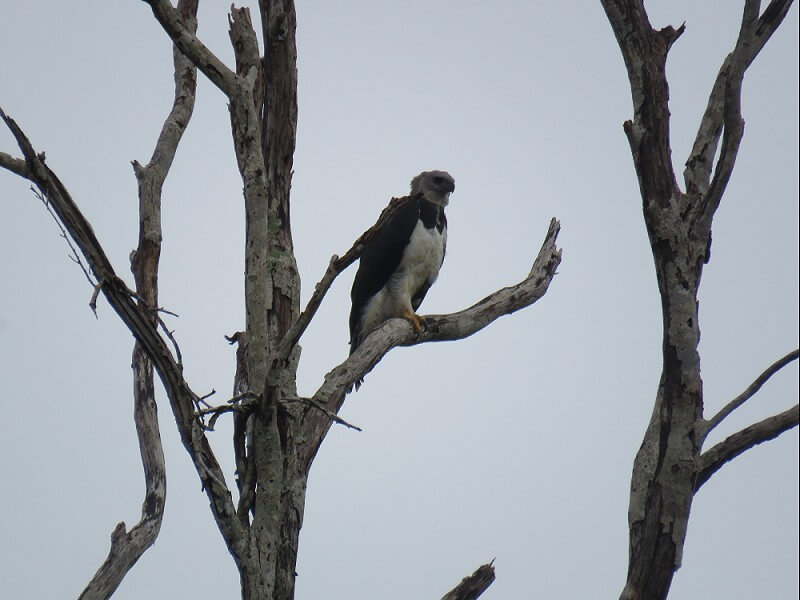 Harpy Eagle Harpia harpyja (Arjan Dwarshuis)
Harpy Eagle Harpia harpyja (Arjan Dwarshuis)
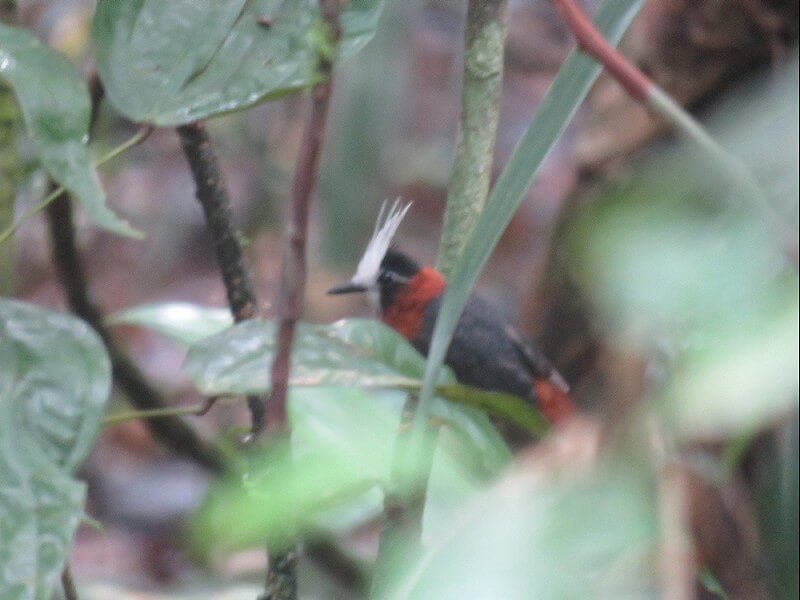 White-plumed Antbird Pithys albifrons (Arjan Dwarshuis)
White-plumed Antbird Pithys albifrons (Arjan Dwarshuis)
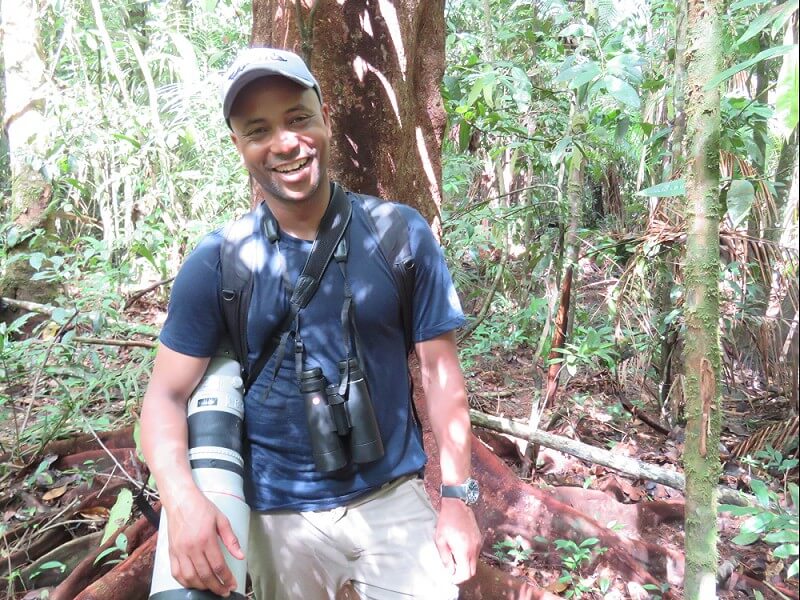 Humberto after 10 Km on the trail (Arjan Dwarshuis)
Humberto after 10 Km on the trail (Arjan Dwarshuis)
July 11th BACK TO CIVILIZATION
We had one more morning birding the trails of Fred’s Berg. Again no Cock-of-the-Rocks, but the constellation prize might have even been better, two stunning male Guianan Red Cotinga’s! These fiery red birds are just too good to be true so thanks Sean for finding them on their not so striking call.
Quality this morning was just of the chain and our Cotinga sighting was followed by a very showy male Band-tailed Antshrike, one of the most desired Guianan Shield endemics.
While we had breakfast at a clearing in the forest I was carefully scoping the canopy and with a coffee in one hand and scope in the other I found both a male Glossy-backed Becard and a pair of Dusky Purpletufts, two very difficult species and true Surinam specials.
To finish things off we found another ant swarm and this time, besides White-plumed- and Rufous-throated Antbirds, we found the rare Red-billed Woodcreeper. What a morning!
After one more swim back at the camp we packed our backs – while being briefly interrupted by a very showy Tiny Hawk feeding on a freshly caught bat! – and headed back to civilization. However Fred had one more surprise for us when he hammered on the roof and yelled ‘STOP’! for the second time in two days. This time there was a magnificent Black-and-white Hawk-eagle staring down at us from an exposed perch, wow!
Back in the northern savannah we checked in at our wonderful accommodation at Colakreek, just 10 minutes from the airport. Tomorrow we have one more day of birding in the northern savannah before I continue to Brazil!
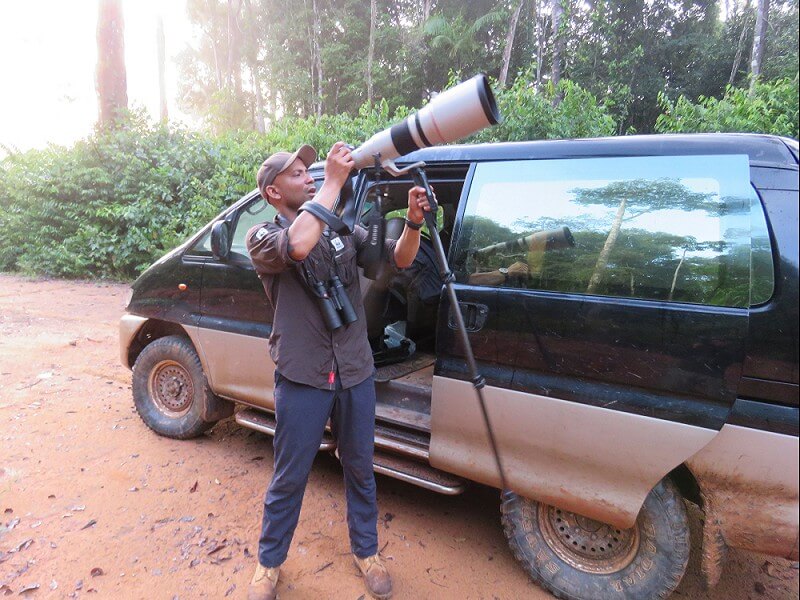 Humberto photographing Black-and-white Hawk-Eagle (Arjan Dwarshuis)
Humberto photographing Black-and-white Hawk-Eagle (Arjan Dwarshuis)
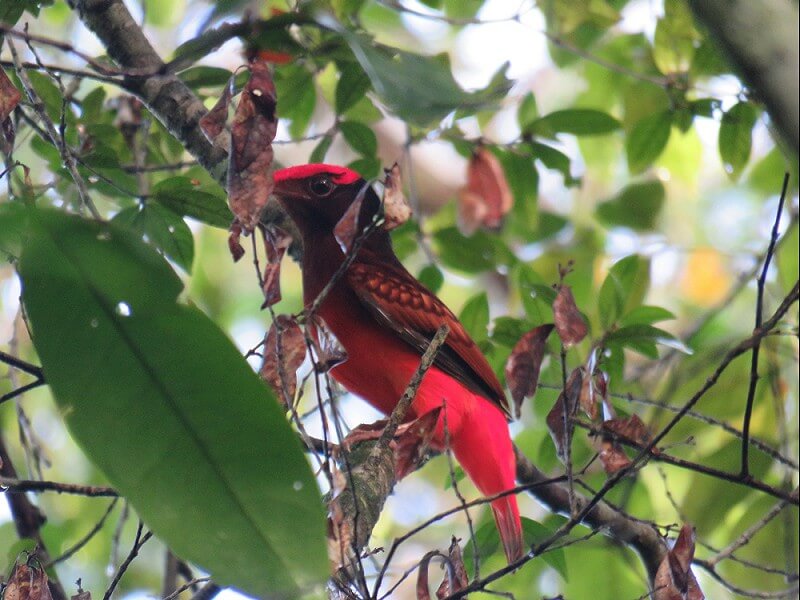 Guianan Red Cotinga Phoenicircus carnifex (Arjan Dwarshuis)
Guianan Red Cotinga Phoenicircus carnifex (Arjan Dwarshuis)
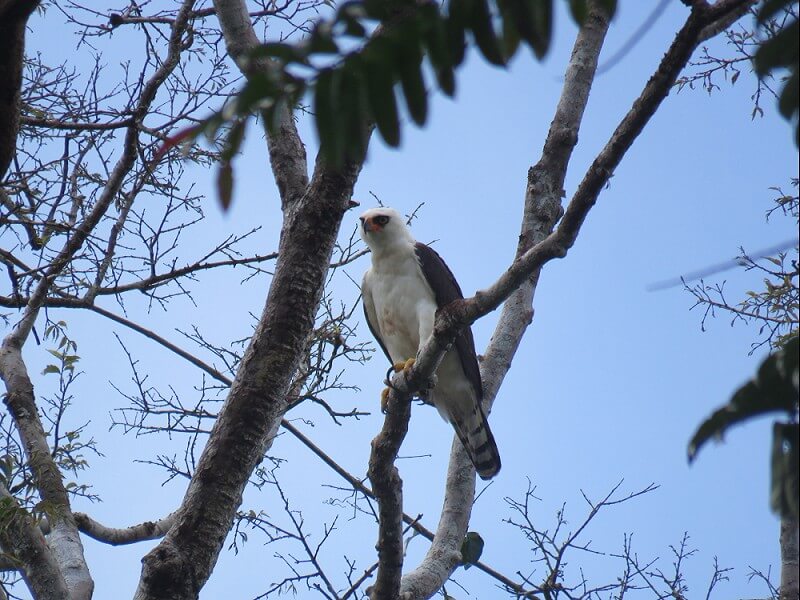 Black-and-white Hawk-Eagle Spizaetus melanoleucus (Arjan Dwarshuis)
Black-and-white Hawk-Eagle Spizaetus melanoleucus (Arjan Dwarshuis)
July 12th GOODBYE SURINAME
We had one last full day of birding in the northern savannah belt and white sand forests near Zanderij Airport in Suriname. Suriname is unique in the sense that very high quality birds can be found right in the vicinity of the international airport and Paramaribo city.
Our first birding site was ‘Kinderboerderij’, a nice stretch of secondary white sand forest with an interesting set of quality birds. During a relaxing two hour walk we found Spot-tailed Antwren, Black-throated Antbird, Pied Puffbird, Glossy-backed Becard, Cayenne Jay and the biggest surprise of all, a female Purple-breasted Cotinga, a first record for this area.
After our morning session we had lunched and went back to Collakreek for a siesta during the heat of the day, but around 4 PM we were back at the savannah surrounding Zanderij, this time finding the range restricted Rufous-crowned Elaenia and lekking Black Manakins.
After a fantastic local dinner it was time to say goodbye to Humberto – he was on an earlier flight back to the Netherlands – and we went for a last owling session before my midnight flight to Brazil. The owling session went ridiculously well and we managed to find both White-tailed- and Rufous Nightjar, multiple Common Pootoos and a very showy Tropical Screech-Owl. Best however was my very last bird in Suriname, a magnificent Black-banded Owl that showed at less than five meters distance! Amazing, what a finish.
Concluding remarks
Suriname was simply off the chain! The birding was spectacular, most roads were good, people were friendly and the forests were amongst the most pristine I’ve ever seen. Moreover it is cheap and the food is great. To me it is a mystery that this fantastic birding destination is not on top of every birders wish list, especially when you have guides like Sean Dilrosum and Fred Pansa.
In my opinion Fred’s Berg will grow to be one of the top Upper Guianan and maybe even neotropical birding destinations. I will surely come back here once the place is finished and I can recommend any birder reading this to do the same! You can reach Sean Dilrosum personally via +5978272021 and Fred Pansa via +5978948661 or via Facebook Fred Eco Tours Suriname.
I can also tell you that Michiel is doing much better, the treatment worked and it looks like they managed to cure his malaria. Good news, I hope you’re back on your feet as soon as possible!
Off to Brrrrrrrrrrrrrrrrrrrrrrrrrrrazil!
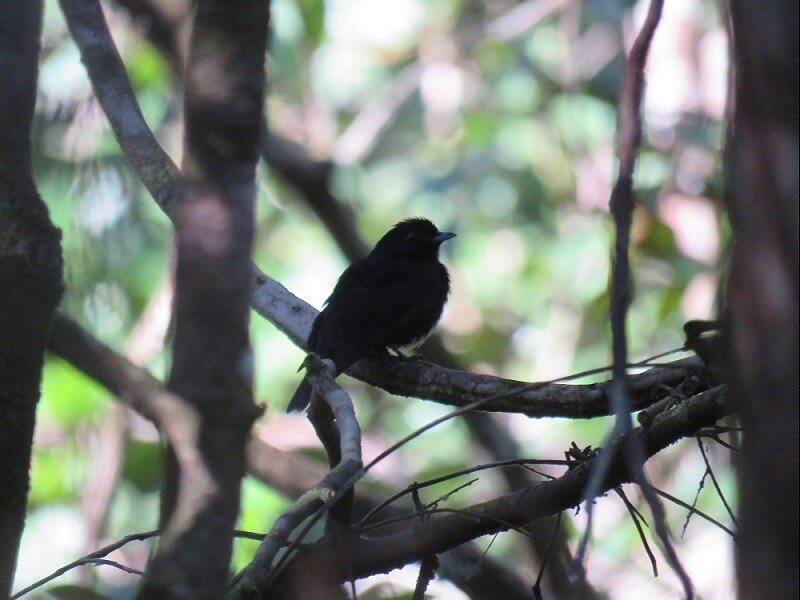 Black Manakin Xenopipo atronitens (Arjan Dwarshuis)
Black Manakin Xenopipo atronitens (Arjan Dwarshuis)
July 13th A LONG TRAVEL DAY
Last night I had left Suriname and now I was heading for Boa Nova, Brazil. Before I would get there I would have to make 3 (!) layovers (in Cayenne, Belem and Brasilia). Finally around 4 PM I arrived in Salvador where Ies Goedbloed – my friend and travel companion for the next 5 weeks – was already waiting for me with the rental car. From Salvador we drove more than 450 kilometres southwest to the small town of Boa Nova.
Just before we arrived in our hostal we saw a nightjar on the road that proved to be a fantastic Scissor-tailed. However there was still a mega sighting waiting for us…
As I was checking in Ies heard a soft ‘whoo’ coming from a palm in the middle of the town square. And there – we couldn’t believe our eyes – sat a Stygian Owl!! What a mega start to our 2 days in Boa Nova. Een goed begin is het halve werk, as we say in Dutch!
July 14th ANTBIRD FIESTA
Boa Nova is something special, it is the primary birding locality on a northeastern Brazilian birding itinerary for two reasons; there is good, reasonably well protected wet forest 20 minutes east of town and there is fantastic dry caatinga woodland right at the doorstep of town. Additionaly, there are some very range restricted endangered species that are only found here, most famous being the monotypic Pink-legged Graveteiro.
Today we were on our own, trying to notch up as many specialties as possible, but luckily tomorrow we will have help from local guide Josafa Almeida and his son. When you see the long list of Boa Nova specialties it is easy to understand that we had a huge task at hand – especially since July is possibly the worse time of the year to be here – if we would see the predominant part of them, but we were eager to bird our asses off today 🙂
We decided to start with the wet forest, walking a small trail known to have nearly all the wet forest-specialties. We had barely parked our car when we hit our first flock and 15 minutes later we had Striated Softail, Bahia Spinetail, Tufted Antshrike, Ochre-faced- and Yellow-lored Tody-flycatcher, Rio de Janeiro Antbird and White-collared Foliage-gleaner in the bag. Wow! We were on a good start.
After feasting our eyes on a very cooperative Least Pygmy-owl it was time to hit the trail. Here it was slow going, not because there were too little birds, on the contrary, we made very little progress because birds were everywhere. And not just your ordinary species. We’re talking about Spotted Piculet, White-eyed- and Buff-fronted Foliage-gleaner, Green-backed Becard, Cryptic Antthrush, Ferruginous- and Scaled Antbird, Sharpbill, Pin-tailed- and Swallow-tailed Manakin, Surucua Trogon and Black-billed Scythebill to name just a few…
After this big success in the wet forest we drove west to the dry caatinga, en route picking up the rare Dubois’s Seedeater.
At the dry forest there was absolutely zero activity during the heat of the day, but I had a plan: ‘let’s start taping in some antbirds’. And so began our afternoon antbird fiesta! In three hours’ time, along a 50 meter stretch of road, we taped in eight species of range-restricted antbirds, in fact all the antbirds that we absolutely needed to see here! We ended our run with Caatinga-, Narrow-billed- and Black-capped Antwren, Slender- and Stripe-backed Antbird and Sooretama Slaty-, Planalto Slaty- and Silvery-cheeked Antshrike and a day total of over 70 species. The predominant part of them being lifer for both Ies and me and all of that without any guiding! Sorry for this unusually lengthy blog, but today was just too awesome 🙂
Cliff Flycatcher Hirundinea ferruginea (Arjan Dwarshuis)
July 15th CHASING THE REMAINING BOA NOVA SPECIALTIES
Today we had help of Josafa Almeida and his son. They didn’t speak a word of English, but with help of Google translate and Wi-Fi in our car we could communicate with them. Most importantly they knew their birds really well and at 5 AM we were on are way with our target list.
We started exactly where we ended yesterday and just as the sun rose over the caatinga we were looking at a very showy White-browed Antpitta.
Today was quiet in the dry forest especially since we more or less cleaned up the day before, subsequently it took us three hours to track down Grey-headed Spinetail, Black-bellied Antwren and Stripe-breasted Starthroat.
After a visit to a roost of the range-restricted Pygmy Nightjar in a peculiar rocky landscape dominated by cactuses, we had a quick lunch in Boa Nova and at 1 PM we headed towards the wet forest.
Our main quarry was the rare Fork-tailed Tody-tyrant, a species with a tiny range only found near Boa Nova. I expected a long and probably unsuccessful search during the heat of the day, but as soon as we parked the car we walked into a flock of birds and two minutes later I found a pair of Tody-tyrants, fantastic! Even better – not rarity wise but experience wise – was a Crescent-chested Puffbird feeding on a small black-and-white snake.
Next we drove and hour to the site for the main attraction of Boa Nova, the Pink-legged Graveteiro! After a bumpy drive on a bad road, pushing our rental car to the max, we arrived at the spot and there it was easy. We played a tape and moments later two Graveteiros were singing from the treetops around us!
Our final stop was at after sunset at a small marsh were we watched – and especially heard – several displaying Giant Snipes. This snipe-on-steroids was a fantastic finish to our two days at Boa Nova where we did amazingly well given the short timespan. Now it was time to drive 600 kilometers back to Salvador to catch our early morning flight to Cuiaba, gateway to the Pantanal!
Pink-legged Graveteiro Acrobatornis fonsecai (Arjan Dwarshuis)
July 16th HYACINT MACAWS, SERIEMA’S AND RHEA’S – PANTANAL BABY!
After a 600 km drive at night, a couple of hours sleep in a chair on Salvador airport and a connecting flight via Brasilia to Cuiaba, we were on our way to the Pantanal, one of the greatest natural wonders on our planet! We were in the very capable hands of Bianca Bernardon, a guide for Birding Pantanal (birdingpantanal.com). Bianca did her Master degree in ornithology on the Mato Grosso Antbird and subsequently she knows the Pantanal intimately well.
The Pantanal is one of the largest floodplains in South America and besides over 500 species of birds it is the best place in the world to see Jaguars, 6 other cat species, Tapirs, Anaconda and Giant Anteaters, and of course huge quantities of Caiman and Piranha.
As we drove out of Cuiaba and into the Pantanal it was cloudy, windy and cold; a ‘cold spell’ had arrived. With cool weather blowing in from the southeast the temperature had dropped more than 10 degrees. Hopefully this wouldn’t affect our birding too much…
We started well with a fantastic pair of Hyacint Macaws nesting in a roadside tree. Wow, what a fantastic experience to see the largest parrot in the world!
After we’d checked in at the wonderful Piuval Lodge we went birding on the floodplain and in some forest patches, but the unusually cold weather made things difficult. Still we finished the day with two new bird families for me, the incredible Red-legged Seriema and the ostrich-of-the-new-world, the Greater Rhea. Best however was a pair of Bare-faced Curassows and a pair of the rare Chestnut-bellied Guan. We had done incredibly well on the Pantanal’s unique mega fauna, the main reason for a birder to come to this amazing place.
July 17th THE PANTANAL EXPERIENCE!
When we woke up this morning it was still more chilly than usual in the Pantanal, but the wind and the clouds were gone, ideal conditions if you’re planning to bird all the way through midday. Yes Bianca had grand plans, after our morning birding session in the woodlands surrounding Piuval we would drive all the way to the Porto Jofre fields, more than 100 km further south in the Pantanal.
The morning session was splendid with Greater Rheas and Red-legged Seriemas patrolling the fields in the distance and Jabirus and Limpkins dotted across the horizon. We were in the Pantanal!
After a quick snack we started heading south, deeper into the Pantanal floodplain and as we made steady progress across the Transpantanaria the landscape got wetter and wilder. Before we knew it we felt like being in a BBC documentary. Everywhere were Kaimans and water birds, in huge quantities, exactly how I’d imagined the Panatanal.
The best bird we got en route was a smashing Scarlet-headed Blackbird, but the absolute highlight was a Giant Otter Bianca found on call (she heard a baby otter yelping from its borrow under one of the many Transpantanaria bridges, after we waited for a while the mother appeared)!
Around the Porto Jofre fields we found several quality birds like Subtropical Doradito, Southern Scrub Flycatcher, White-bellied Tyrannulet and Sungrebe.
When it got dark we drove back north to the Porto Jofre hotel when suddenly there was a cat crossing the road, an Ocelot! Today we experienced that true Pantanal feeling everybody who’s been there talks about…
Scarlet-headed Blackbird Amblyramphus holosericeus (Arjan Dwarshuis)
Mosquitos (Arjan Dwarshuis)
July 18th FROM THE FLOODPLAIN TO THE CERRADOS
Already our last morning in the Pantanal wherein we had both a boat trip and a trail planned. We started with a pre-breakfast hour of birding on the Porto Jofre airstrip that produced a very cool Collared Forest Falcon.
On the river we got lucky with a flock of Nanday Parakeets and for Ies a lifer Boat-billed Heron and a very showy Sungrebe, another classic set of Pantanal specialties. At the end of the boat ride we were dropped at the far end of a loop trail, which begins behind the Porto Jofre hotel. Our main quarry here was Bianca’s Master degree study subject, the enigmatic Mato Grosso Antbird. These beatiful jet black antbirds are luckily quite common and shortly after we set foot on the trail we found a pair followed not long thereafter by another special, the Band-tailed Antbird.
After checking out at the Porto Jofre Hotel we left the Pantanal and headed for the dry cerrados of Chapada dos Guimaraes!
Itineraries are short and effective when on a big year, but I will surely come back to the amazing Pantanal to look for Giant Anteaters, Jaguars and Pumas!
Mato Grosso Antbird Cercomacra melanaria (Arjan Dwarshuis)
July 19th WORKING HARD FOR HARD BIRDS
When we woke up this morning at the Pousada Cambara it was windy and cold, but luckily there was the most elaborate home made breakfast I’d ever seen waiting for us. After this feast we drove to our first birding locality in the dry cerrados. This forest type is under huge pressure from logging and burning to make way for agriculture and subsequently birds are suffering, especially the rare Yellow-faced Parrot. Once a common sight in central Brazil this species has become very rare over the course of the last decades and sightings of this enigmatic parrot have become irregular around Chapada dos Guimares. In fact they are hardly ever found on regular birding itinerary any more. Naturally we were hoping, just a little bit, that we would see one…
We had to work hard to find good birds in the cerrados because the cold windy conditions meant that there was very little activity. Still we started well with a smashing male Horned Sungem – one of our main targets – and a fantastic perched Orange-breasted Falcon, but after a full morning of birding we had seen just a hand full of cerrados specialties. Would the afternoon bring the game-changer we were longing for?
We had lunch – prepared by her father who practices Agua Farming (a much needed form of sustainable farming that will one day incorporate agriculture in forest conservation) – at Bianca’s home on a ranch surrounded by beautiful riverine forest and it was here after lunch that we had our game-changer in the form of a Small-billed Tinamu followed quickly by a Sharp-tailed Streamcreeper foraging on rocks on the stream that runs through the property. Great!
Indeed the afternoon was much better with Shrike-like Tanager, some more Horned Sungems and best of all a male Blue Finch. Then it happened, in the dying seconds of the day… I saw a Parrot approaching from the right with perfect light in the back. I yelled ‘Parrot’! We lifted our bino’s and there was a Yellow-faced Parrot showing incredibly well as it flew by 3 stunned observes. A glorious big day moment…
Curl-crested Jay Cyanocorax cristatellus (Arjan Dwarshuis)
Horned Sungem Heliactin bilophus (Arjan Dwarshuis)
July 20th ON TO THE RIO AZUL!
Already our last morning in the cerrados and after our big day yesterday there were few targets left, almost all of them hard to find species. Our main target was the Collared Crescentchest, an unusually stunning Tapaculo species and a true cerrados specialist. Luckily we received spot-on site info from three Ecuadorian birder who also stayed in the Pousada Cambara and who had seen this bird the day before. The info proved spot-on indeed because right at dawn we found the Crescentchest singing on top of a small bush, great and thank you guys!
Other good birds were Rufous-winged Antshrike, White-eared Puffbird, White-rumped Tanager and several displaying Chapada Flycatchers, a recently described species.
Then it was time to say goodbye to Bianca and thank her for a fantastic and highly successful five days. Thanks Birding Pantanal for putting this crazy itinerary together and for anyone planning to visit this incredible birding hotspot, please go to www.birdingpantanal.com.
On to the Rio Azul!
July 20th THE RIO AZUL JUNGLE LODGE
Yesterday afternoon we had arrived at Alta Floresta airport along with our guide for the next five days, Bruno Renno. Upon arrival we were met by Carlos – the son of the lodge owner – who escorted us during the three hour long transfer to the Rio Azul Jungle Lodge, a family run sports fishing eco-lodge that has recently been discovered as one of the top birding sites in the Brazilian Amazon. Two recently described species in particular are almost exclusively found here, the Bald Parrot and the Tapajos Hermit. In addition to these two world rarities the lodge list now stands at over 500 species and with new species found every month this total is bound to grow towards 550 or even 600 in the near future.
After a sweaty, bumpy drive we finally arrived at the lodge, where we were welcomed by the family and some cold drinks and as the sun set behind the rainforest canopy we scoped a flock of seven different tanager species from the lodge clearing. Let the fun begin!
O I almost forgot to mention that the food at this place is absolutely amazing and for me – being a very fanatic hobby cook – this was another big highlight!
July 21th IN SEARCH OF THE BALD PARROT
Of course there was one bird we hoped to see most at the Rio Azul Jungle Lodge, the Bald Parrot. Carlos and his father were optimistic about our chances if we would join them on a boat ride downstream. We encountered some delay in form of a nice male Glossy Antshrike and a Layard’s Woodcreeper and subsequently we were a little late to try for Zigzag Heron; well that little heron has to come later during our stay 🙂
As we drifted downstream Bruno picked up and taped in one fantastic bird after another and soon it became clear that this guy was absolutely phenomenal with birds sounds of the Brazilian Amazon. In fact he must be one of the best guides I’ve ever had the pleasure of birding with. Highlights were many, but special mentioning goes to an exceptionally showy Razor-billed Curassow, a female Crimson Topaz, a male Long-billed Starthroat, a pair of the huge Long-billed Woodcreeper, Dot-backed Antbird, Madeira Parakeet, Gould’s Toucanet, Red-necked Aracari and a female Spangled Cotinga.
Then it happened, Bruno screamed ‘Look!’ and two Bald Parrots flew overhead showing the distinctive red underwing coverts and bald head. It went all too quickly, but we had just seen one of the most enigmatic Parrot species of the New World! Yes!
As soon as we set foot on land we walked into an army ant-swarm and moments later we watched the recently described Xingu Scale-backed Antbird showing its diagnostic black throat.
After a positively heavenly good lunch we went off into the forest again. We had barely walked 20 meters when Bruno heard a distant Pavonine Quetzal, one of my all-time most wanted Neotropical birds! Bruno gave the bird some playback and it immediately flew in and started calling right above our heads, amazing!
The remaining part of the afternoon was fairly quiet, but we did see both White-crested- and Golden-crowned Spadebill and an Ocellated Poorwill, which we flushed from the forest floor. A good first day at the Rio Azul!
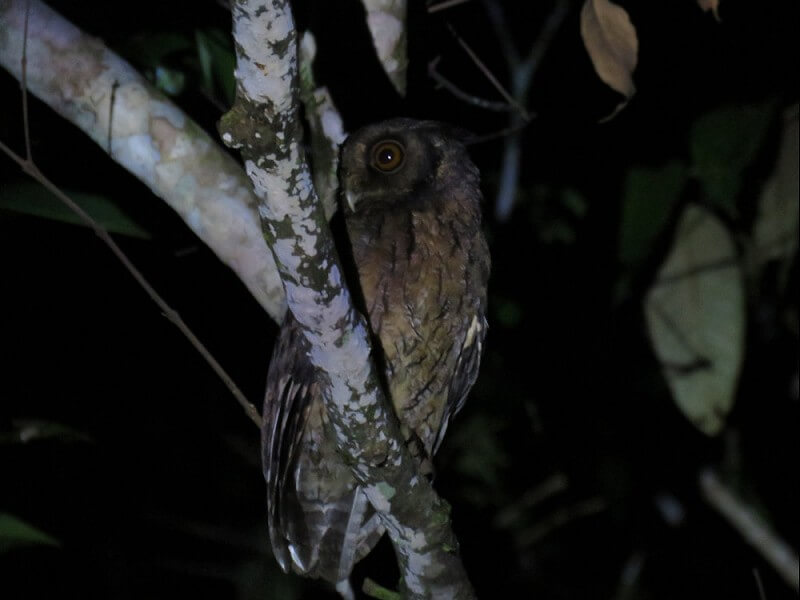 Tawny-bellied Screech Owl Megascops watsonii (Arjan Dwarshuis)
Tawny-bellied Screech Owl Megascops watsonii (Arjan Dwarshuis)
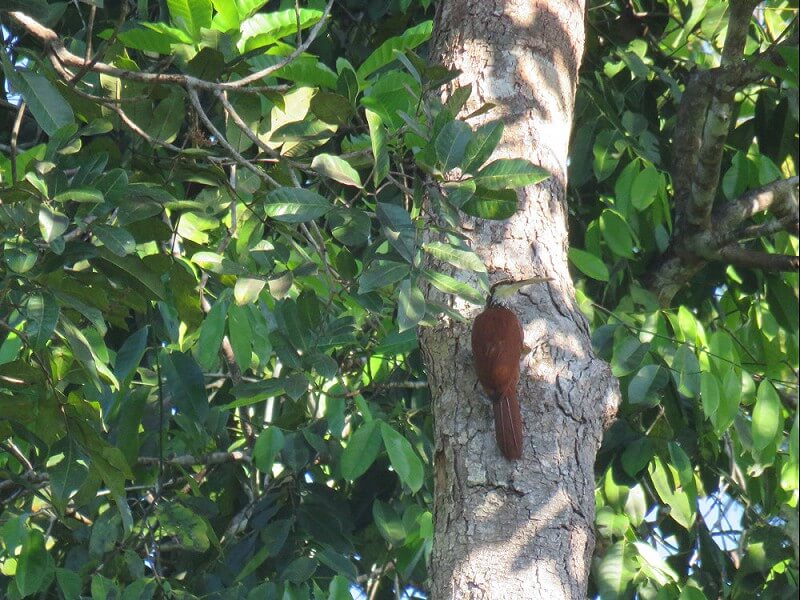 Long-billed Woodcreeper Nasica longirostris (Arjan Dwarshuis)
Long-billed Woodcreeper Nasica longirostris (Arjan Dwarshuis)
July 22th THE TAPAJOS HERMIT
Another species almost unique to the Rio Azul Jungle Lodge is the Tapajos Hermit. Described just a couple of years ago this enigmatic little hummingbird has proven very reliable around a patch of red-flowering bushes behind the lodge clearing. Last year a Brazilian film crew even visited the lodge to devote an item to the Tapajos Hermit.
Around sunrise – just after taping in the rare Uniform Woodcreeper – we walked over to the red flowering bushes and there – almost too easy to be true – was the rare Tapajos Hermit feeding actively on those beautiful little red flowers, fantastic! We decided to come back in the afternoon for some photographic documentation of this little known bird, but now it was time to hit the trail.
We started birding the entrance road that runs through some savannah habitat, this proved an excellent choice since Bruno brilliantly picked up a Pale-bellied Mourner on call. This guy is something else when it comes to Amazonian bird sounds!
We spent the rest of the day on the trails through varzea, terra firma and transition forest, looking for specialties, but during the heat of midday we staked out those little red flowers for that little red Hermit. I managed to get some great video and Bruno got some stunning pics.
Today we heard some heartbreaking stories from Carlos about deforestation in Brazil. As we walked through a neighboring range we noticed that almost all the large trees in this area were marked. Carlos told us that these forest giants were soon to be ‘harvested’ for ‘sustainable forest management’, this was written in the ‘codigo florestal’ or Brazilian forest code. We are talking trees that take hundreds of years to reach their height of over 40 meters tall. With the new forest law in Brazil all these trees are allowed to be harvested, as long as they leave the small trees standing. In theory they can come back in 30 years to harvest again. In theory… Here are the facts: (1) THIS IS NOT BASED ON ANY STUDY. (2) ALL THE ANIMALS DEPENDING ON LARGE TREES DISAPPEAR FOREVER (3) THERE IS VERY LITTLE CONTROL (4) MANY PEOPLE IN HIGH POSITIONS GET FAR TOO RICH.
Of course this ‘forest management’ is not sustainable at all, with every huge tree that is harvested 20 or so trees in the direct vicinity die as well. To make things worse they are now trying to pass a new constitution that allows any mega construction project – like hydro dams – to be initiated regardless the possible environmental effects….
Naturally Carlos was sad and felt frustrated about these environmental crimes happening in his own country and we felt that pain with him.
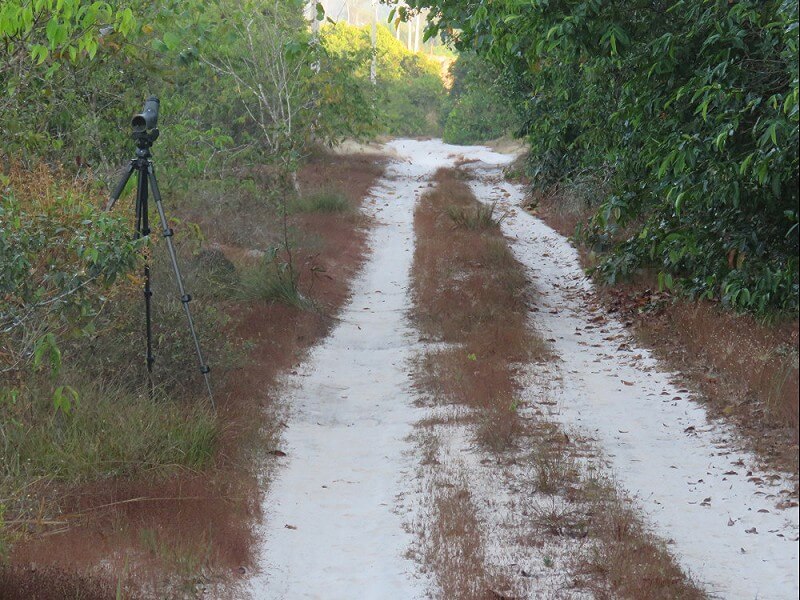 Road through white sand in the Rio Azul area (Arjan Dwarshuis)
Road through white sand in the Rio Azul area (Arjan Dwarshuis)
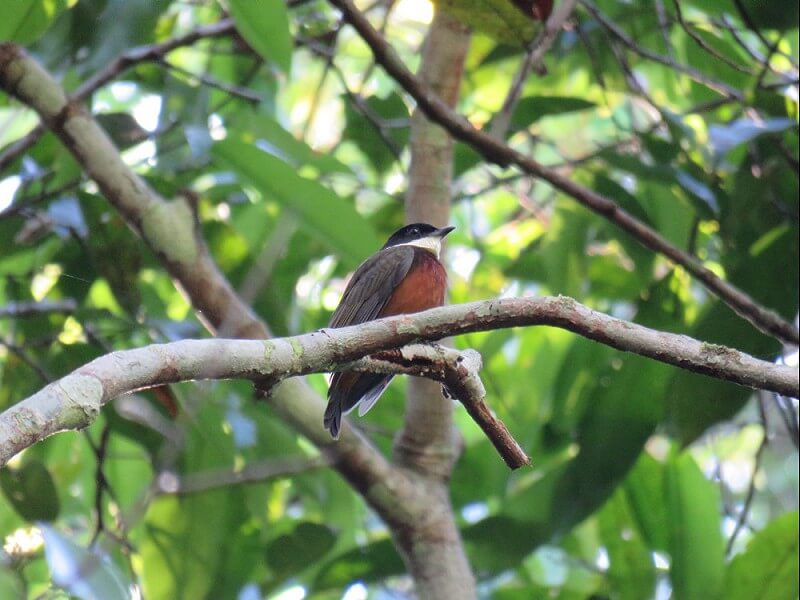 Flame-crowned Manakin Heterocercus linteatus (Arjan Dwarshuis)
Flame-crowned Manakin Heterocercus linteatus (Arjan Dwarshuis)
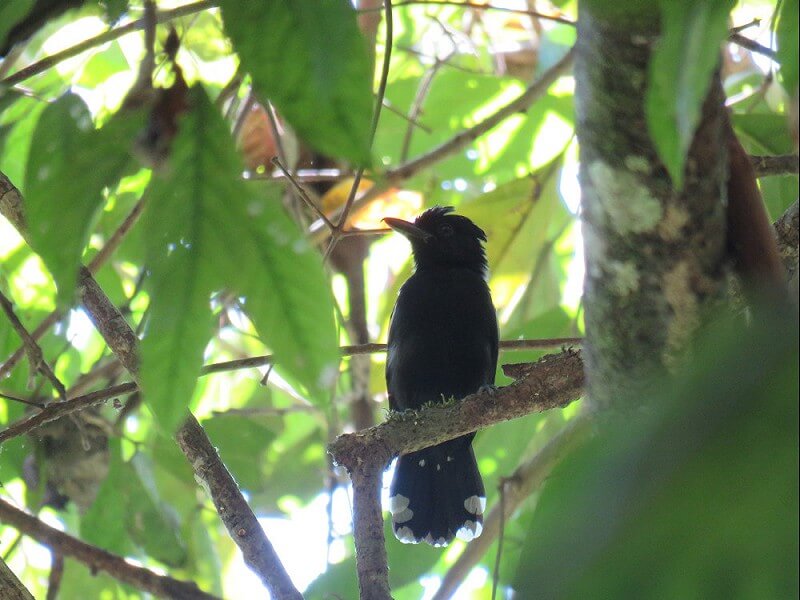 Glossy Antshrike Sakesphorus luctuosus(Arjan Dwarshuis)
Glossy Antshrike Sakesphorus luctuosus(Arjan Dwarshuis)
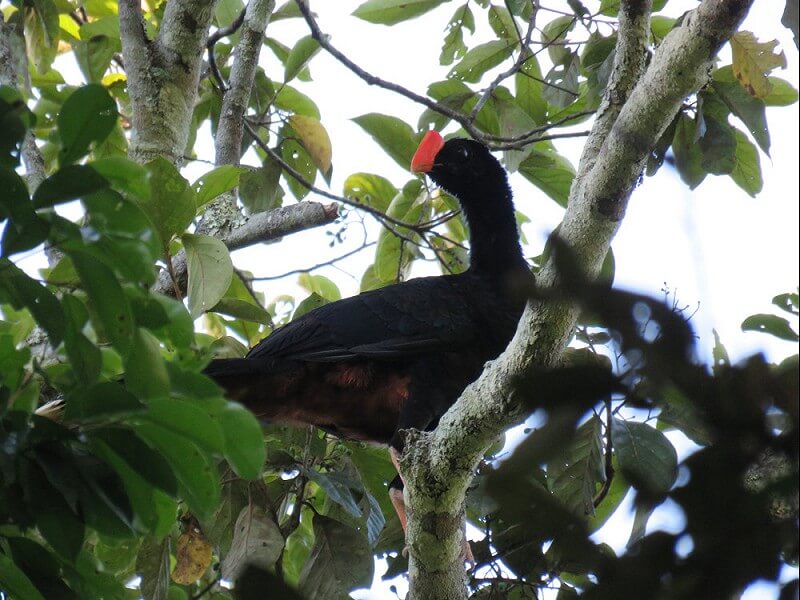 Razor-billed Currasow Mitu tuberosum (Arjan Dwarshuis)
Razor-billed Currasow Mitu tuberosum (Arjan Dwarshuis)
July 23th A MEGA DAY!
Sometimes a day starts a bit slow, but this day can suddenly turn huge trough a couple of once in a lifetime sightings. Today was such a day…
The first hour on the trail went by rather uneventful when out of the blue a huge raptor approached us from left through the rainforest canopy, an adult HARPY EAGLE! My second sighting in two weeks’ time! Even better, it was a new bird for Ies and seeing your first Harpy is a thrilling moment for every birder.
Another hour passed without much happening, but then a CRYPTIC FOREST-FALCON started calling and not long thereafter we had incredible views of a pair of this enigmatic little raptor.
Half an hour later we heard a Plain Brown Woodcreeper calling from the side of the track, an antswarm was near! We walked over to where the sound had come from. A movement in the undergrowth, we aimed our bins, ‘BARE-EYED ANTBIRD’!!
After this incredible morning session we walked back to the lodge euphorically. Than it happened. A huge raptor flew up from the side of the track barely 10 meters away from us. The same Harpy! We thought… The bird perched 40 meters away from us on the other side of the clearing, I aimed my scope and couldn’t believe my eyes. Barred underbelly, black mask, pale head… CRESTED EAGLE!!! For a magical 15 minutes we enjoyed scope views of one of the rarest birds in the amazon. Magic…
But the day wasn’t over yet… After another heavenly lunch – great food on a great day makes that day even better – Bruno and I went to look for the eagle again. We didn’t find the eagle again, but we did find the rare Para Gnatcatcher in a canopy flock!
After all that mayhem we joined Carlos Sr. for a relaxing late afternoon boat trip downstream. The sun had already set when suddenly a ZIGZAG HERON started calling from inside the forest and after some skillful playback from Bruno we enjoyed amazing views of a calling male in the light of our torch. Pfewwww, time for a beer, or two….
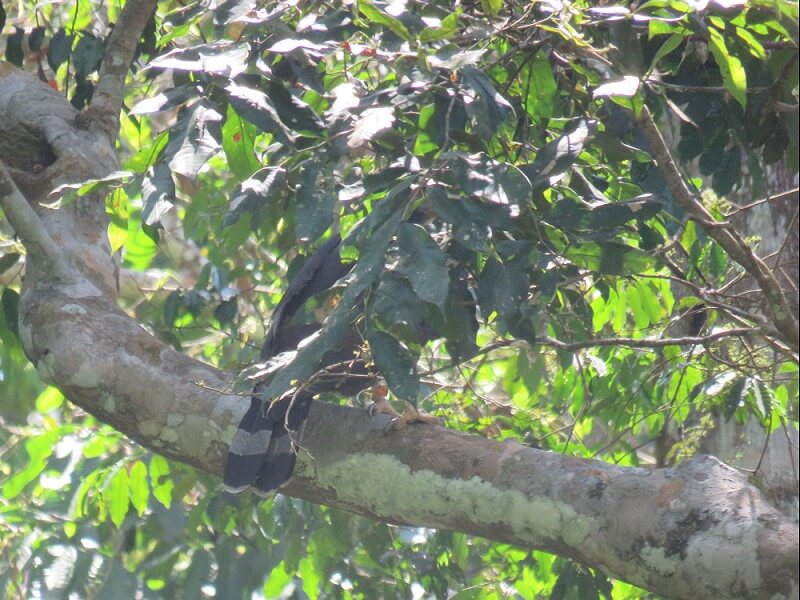 Crested Eagle Morphnus guianensis(Arjan Dwarshuis)
Crested Eagle Morphnus guianensis(Arjan Dwarshuis)
July 24th HARD WORK ON THE TRAILS
After yesterday’s events on the trails we thought we had deserved another boat ride this morning. We had a rocking start with a fantastic sighting of a Brazilian Tapir – representing a new mammal family for both Ies and me – while drifting downstream.
It was quiet with respect to birdlife along the river, but that all changed when we discovered a White-bellied Dacnis perched on top of a riverside tree. We had excellent scope views of this mega Amazonian rarity before it vanished in the canopy. Another memorable sighting was a male Crimson Topaz feeding on insects above the river.
On the trails it was rather quiet today so we decided to go on the river once more in the afternoon. This proved an excellent choice since we found a group of 5 Curl-crested Aracaris along the river.
That night we had another amazing dinner at the Pousada; man I’m gonna miss the amazing food at the Rio Azul!
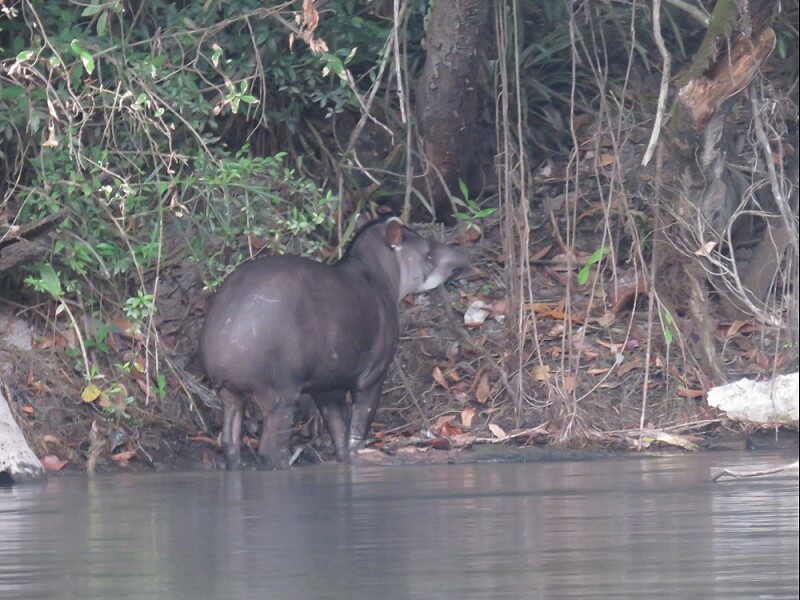 South American Tapir Tapirus terrestris (Arjan Dwarshuis)
South American Tapir Tapirus terrestris (Arjan Dwarshuis)
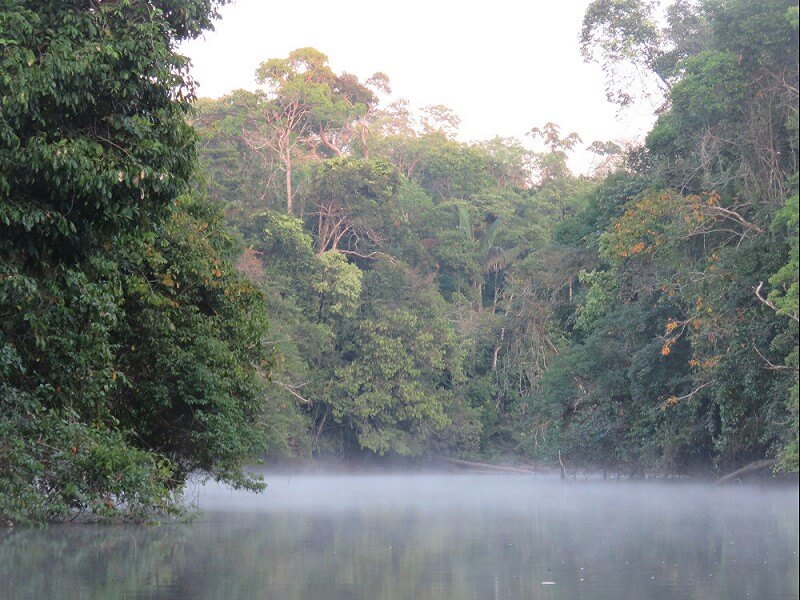 Rio Azul rain forest (Arjan Dwarshuis)
Rio Azul rain forest (Arjan Dwarshuis)
July 25th ON TO THE ATLANTIC RAINFOREST!
We had 2 hours left on the trails with Bruno before our taxi would arrive to take us back to Alta Floresta airport for our connecting flight to Sao Paulo. During those two hours we managed to find two new birds and luckily they were exciting once namely a Bicolored Hawk and the weird Ringed Antpipit.
Then it was time to say goodbye to the fantastic Rio Azul Jungle Lodge and commence with a long day of traveling towards Itatiaia National Park.
Our stay at the Rio Azul Jungle Lodge was absolutely amazing, not just for the great birds, but also for their hospitality and fantastic food. We felt right at home and will definitely come back someday. And for any birder reading this; well you’ve seen the list of birds, better get your ass down there as soon as possible because it’s absolutely worth it!
Bruno Renno’s guiding was simply top-notch. He is without doubt one of the most knowledgeable people out there when it comes to Amazonian birds and especially their calls. I can highly recommend him to any birder or group of birders visiting this amazing biome, you will definitely not regret it!
On to the Atlantic Rainforest!










